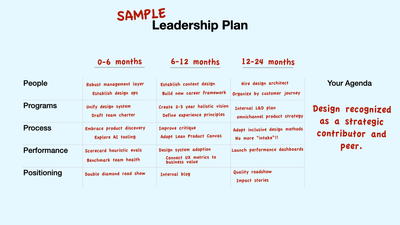Craft Your Leadership Plan with These 5 P's
Recently, a head of design shared with me how their UX metrics work was being taken up by their product
To Lead Design, You Must Have an Agenda
That Vision Thing
About a year ago, I distilled the conversations Jesse and I had been having with design executives
On the (f)utility of design maturity models
Thesis
Design maturity models are oversimplified frameworks that mask the necessary nuance to understand and develop an organization's
UX/Design Leaders: Understand the motivation of your peers and stakeholders the same way you do your users and customers
UX/Design leaders often get caught up in their personal missions, their narratives of change and impact, and believe they
New masterclass: "From Ladder to Trellis: Flexible Career Architectures for UX Teams"
Since I've become independent, perhaps the most common request of my time is helping companies develop good career
Design leadership is change management
Over the holiday break, I reviewed the 5 conversations that Jesse and I have conducted with truly senior design executives

